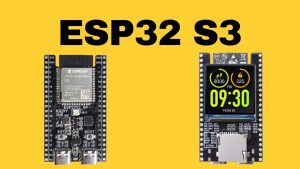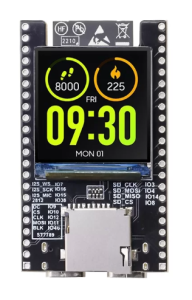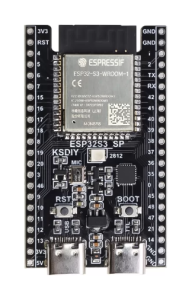Introduction

In the ever-evolving landscape of microcontrollers and Internet of Things (IoT) technology, the ESP32 S3 emerges as a beacon of innovation and versatility.
This chip, developed by Espressif Systems, marks a significant leap forward, offering many features that cater to seasoned developers and enthusiastic hobbyists alike. Its unique blend of power, efficiency, and connectivity options places it at the forefront of microcontroller technology.
It is ideal for applications ranging from simple home automation to complex industrial systems.
Unveiling the ESP32 S3
An In-depth Look at Its Features and Capabilities
The ESP32 S3 boasts an impressive array of technical specifications that set it apart in the microcontroller market.
At its core, the chip features a powerful, high-performance dual-core processor that facilitates efficient multitasking and handling complex operations, a critical factor in today’s demanding applications.
Its advanced connectivity options are a hallmark of its design, supporting Wi-Fi and Bluetooth interfaces. This connectivity is not just about linking to networks but is also about enabling seamless integration into IoT ecosystems, where devices communicate and interact in increasingly sophisticated ways.
Moreover, the ESP32 S3 is designed with a keen focus on security.
In a world where data breaches and security threats are becoming more prevalent, the chip’s integrated security features ensure that applications built on it are robust against such challenges.
This security aspect is crucial for developers working on applications that handle sensitive data or operate in critical environments, such as healthcare or finance.
Programming and Development Ecosystem
One of the standout features of the ESP32 S3 is its user-friendly programming environment.
Espressif has ensured that developers have access to a rich set of tools and libraries that make programming the ESP32 S3 not just accessible but also enjoyable.
The support for various programming languages, including Python and C++, opens the chip to a broad audience, from beginners to advanced users. Additionally, the ESP32 S3’s compatibility with popular development platforms and its extensive documentation and community support further adds to its appeal as a microcontroller that is easy to work with, regardless of the project’s complexity.
Applications of the ESP32 S3
Versatility Across Various Domains
The ESP32 S3’s power, connectivity, and security combination make it an ideal candidate for many applications. In-home automation, for instance, its ability to interface with various sensors and actuators and its network connectivity, allows for the creation of sophisticated and integrated smart home systems.
Similarly, the ESP32 S3 can be the cornerstone of monitoring and control systems requiring real-time data processing and reliable communication in industrial applications.
Its low power consumption makes it suitable for battery-powered or energy-conscious applications, extending its usability to portable and remote devices.
Furthermore, the ESP32 S3’s capabilities extend to areas like wearable technology, where its compact size and efficiency are valuable assets.
In these applications, the chip can process sensor data, provide user interface functionalities, and connect to other devices or cloud services, all while maintaining a small footprint and maximizing battery life.
Exploring the Future with ESP32 S3
Innovation and Beyond
The potential of the ESP32 S3 extends beyond its current applications, positioning it as a catalyst for future technological innovations.
As the IoT landscape continues to grow, the demand for more intelligent, interconnected devices is rising. The ESP32 S3, with its powerful processing capabilities and versatile connectivity options, is well-suited to meet these evolving needs.
It is poised to play a pivotal role in developing next-generation IoT solutions that are smarter, more efficient, and more integrated than ever.
Moreover, the ESP32 S3’s adaptability makes it a prime candidate for emerging fields such as edge computing and artificial intelligence (AI).
In edge computing scenarios, the ability of the ESP32 S3 to process data locally, rather than relying on cloud-based services, enables faster response times and reduced bandwidth usage, which are crucial for real-time applications.
The chip’s processing power can be harnessed in AI for running lightweight machine learning models, facilitating intelligent decision-making in devices ranging from smart sensors to autonomous robots.
Maximizing the Potential of ESP32 S3
Tips and Best Practices
- Leverage the Rich Ecosystem: Take full advantage of the extensive libraries, tools, and community support available for the ESP32 S3. Utilizing these resources can significantly streamline the development process and enhance the functionality of your projects.
- Focus on Security: Given the chip’s integrated security features, it’s important to implement them effectively in your applications, especially when dealing with sensitive data or critical systems.
- Optimize Power Consumption: Pay special attention to power management strategies to extend battery life and improve efficiency for battery-operated or energy-sensitive applications.
- Experiment with Connectivity: The ESP32 S3’s support for Wi-Fi and Bluetooth opens up many possibilities for device interconnectivity. Experimenting with these features can lead to innovative solutions in IoT and beyond.
Frequently Asked Questions (FAQs) about the ESP32 S3 Article
What is the ESP32 S3?
The ESP32 S3 is a highly versatile and powerful microcontroller developed by Espressif Systems. It’s designed for a wide range of applications, particularly in the IoT (Internet of Things) domain, due to its dual-core processor, advanced connectivity options (including Wi-Fi and Bluetooth), and robust security features.
What makes the ESP32 S3 suitable for IoT applications?
Its suitability for IoT applications stems from its advanced connectivity features, allowing seamless integration into IoT ecosystems. Its powerful processing capabilities enable it to handle complex operations, essential in modern IoT solutions.
Can beginners use the ESP32 S3 easily?
Yes, the ESP32 S3 is accessible to beginners. It supports various programming languages like Python and C++, and a wealth of resources, including extensive documentation and a supportive community, make it easier for beginners to get started.
What are some common applications of the ESP32 S3?
Common applications include home automation systems, industrial monitoring and control, wearable technology, and portable devices. Its low power consumption also makes it ideal for battery-powered applications.
How does the ESP32 S3 handle security concerns?
The ESP32 S3 has integrated security features designed to make applications built on it more secure against data breaches and other cyber threats. This makes it a reliable choice for applications that handle sensitive information or operate in critical environments.
Is the ESP32 S3 good for power-sensitive applications?
Yes, the ESP32 S3 is well-suited for power-sensitive applications. Its efficient power management capabilities allow it to operate effectively in environments where power conservation is crucial, like in battery-operated devices.
Can the ESP32 S3 be used for AI and machine learning applications?
While the ESP32 S3 is not specifically designed for heavy AI or machine learning tasks, its processing power can handle lightweight machine learning models. This makes it suitable for basic AI applications and intelligent decision-making in devices.
What programming environments are compatible with the ESP32 S3?
The ESP32 S3 is compatible with several programming environments, including the Arduino IDE and Espressif’s ESP-IDF. This flexibility allows developers to choose the environment they are most comfortable with.
How does the ESP32 S3 contribute to the future of technology?
The ESP32 S3 is poised to play a significant role in future technological developments, especially in IoT, edge computing, and lightweight AI applications. Its capabilities align well with the growing demand for smarter, interconnected devices.
What should developers focus on when working with the ESP32 S3?
Developers should focus on leveraging the ESP32 S3’s ecosystem, optimizing power consumption, implementing its security features effectively, and experimenting with its connectivity options to fully realize its potential in their projects.
Conclusion
The ESP32 S3 is a testament to the advancements in microcontroller technology, marking a significant stride in IoT and beyond.
Its blend of powerful features – including a dual-core processor, advanced connectivity with Wi-Fi and Bluetooth support, and robust security measures – makes it an ideal choice for a vast array of applications, from simple DIY projects to complex industrial systems.
The chip’s user-friendly programming environment, supported by a rich ecosystem of tools and resources, ensures accessibility to beginners and experienced developers.
As we look towards the future, the ESP32 S3 emerges as a component and a catalyst for innovation in fields like edge computing, artificial intelligence, and interconnected smart devices.
Its versatility and capabilities open up new possibilities for creative and efficient technological solutions. The article invites readers to explore the potential of the ESP32 S3.
It encourages them to envision and realize their innovative ideas using this powerful microcontroller, shaping the future of technology.


